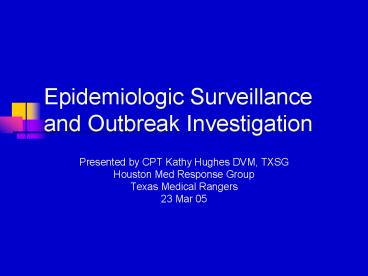Epidemiologic Surveillance and Outbreak Investigation - PowerPoint PPT Presentation
1 / 25
Title:
Epidemiologic Surveillance and Outbreak Investigation
Description:
Epidemiologic Surveillance and Outbreak Investigation Presented by CPT Kathy Hughes DVM, TXSG Houston Med Response Group Texas Medical Rangers 23 Mar 05 – PowerPoint PPT presentation
Number of Views:323
Avg rating:3.0/5.0
Title: Epidemiologic Surveillance and Outbreak Investigation
1
Epidemiologic Surveillance and Outbreak
Investigation
- Presented by CPT Kathy Hughes DVM, TXSG
- Houston Med Response Group
- Texas Medical Rangers
- 23 Mar 05
2
Epidemiology
- The study of diseases and health in populations
- The study of the distribution and determinants of
health-related states or events in specified
populations, and the application of this study to
the control of health problems - Last JM, ed. Dictionary of Epidemiology, Second
edition. New York Oxford U. Press, 1988 42. - Basic science of public health
3
Risk factor
- Exposure associated with occurrence of disease
- Not necessarily causative
4
Outbreak
- Occurrence of increased number of cases of a
disease above the expected frequency
5
Surveillance
- Monitoring diseases in population
- Passive reports submitted by practitioners,
laboratories, hospitals - Reportable diseases
- Active public health officials contact health
care facilities for information
6
Outbreak investigation
- 1. Establish existence of outbreak
- 2. Verify diagnosis
- 3. Develop case definition
- 4. Perform descriptive epidemiology
- 5. Analyze data
- 6. Develop hypothesis
- 7. Test hypothesis
- 8. Refine hypothesis
- 9. Implement control measures
- 10. Write report and disseminate findings
7
Anthrax outbreak
- Fall 2001
- First case of bioterrorism in U.S.
- Investigation led by Centers for Disease Control
(CDC)
8
Anthrax
- Agent Bacillus anthracis
- Inhalational
- Cutaneous
- Gastrointestinal
9
1. Establish existence of outbreak
- 22 cases of anthrax diagnosed October-November
2001 - 11 cases of inhalational anthrax
- Last reported case of inhalational anthrax in
U.S. was in 1976
10
2. Verify diagnosis
- Clinical findings
- Skin lesions, fever, cough, chest pain
- Laboratory findings
- Isolation of B. anthracis from patient
- PCR of B. anthracis DNA
- Immunohistochemical staining
- Serology with ELISA
11
3. Establish case definition
- Confirmed
- Clinical signs plus isolation or 2 supportive lab
tests - Suspected
- Clinical signs plus 1 supportive lab test or link
to environmental exposure
12
Search for more cases
- Search for more cases
- Hospital, clinic, medical examiners
- Staff at affected workplaces
- Reports from law enforcement and public
- Collect data
- Develop and administer questionnaire
- Cases and those potentially exposed
- Test clinical and environmental specimens
- 4 powder-containing envelopes recovered
13
4. Perform descriptive epidemiology
- Who, what, where, when
- Plot epidemic curve
- Dates of onset of illness
- Plot spot map
- Locations of cases
14
(No Transcript)
15
(No Transcript)
16
5. Analyze data
- Calculate frequency rates from descriptive
epidemiology - Age
- Sex
- Occupation
- Case-fatality ratio
17
(No Transcript)
18
6. Develop hypothesis
- Why and how
- 2 separate mailings
- Exposures along path of mail and at delivery
locations
19
7. Test hypothesis
- Evaluate relationship between exposure and
disease - Compared cases between mailings
- Type of occupation
- Form of anthrax
- Cases persons with the disease
- Controls persons without the disease
20
(No Transcript)
21
8. Refine hypothesis
- If original hypothesis failed
- May require further studies
22
9. Implement control measures
- Treatment of cases
- Postexposure prophylaxis
- Inhalational case at workplace
- Environmental specimens at workplace
- 32,000 people received prophylaxis
- No further cases reported
23
10. Write report and disseminate findings
- Numerous papers published on investigation
24
Summary
- Multi-state investigation
- Involved local, state and federal agencies
- Thousands of people potentially affected
25
References and acknowledgments
- Chin J. Control of communicable diseases manual.
2000. American Public Health Assoc, Washington,
DC. p 20. - Dicker R. Principles of epidemiology self-study
guide. Public Health Training Network. Atlanta
Centers for Disease Control and Prevention.
Available from www.phppo.cdc.gov/PHTN//catalog/30
30g.asp - Friis RH, Sellers TA. Epidemiology for public
health practice. 1999. Aspen, Gaithersburg, MD.
pp 52-53. - Jernigan DB, Raghunathan PL, Bell BP, Brechner R,
Bresnitz EA, Butler JC, et al. Investigation of
bioterrorism-related anthrax, United States,
2001 epidemiologic findings. Emerg Infect Dis
serial online. 2002 Oct (cited 2005 Mar)8.
Available from URL http//www.cdc.gov/ncidod/EID/
vol8no10/02-0353.htm - Slater MR. Veterinary epidemiology. 2003.
Butterworth Heinemann, St. Louis, MO. p. - Dr. Paul E. Grunenwald, Harris County Public
Health and Environment Services































